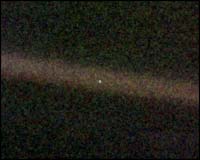My long term memory is honestly rather poor. That makes for easy entertainment as friends relate to me (again and again) seemingly fresh tales of my own stupidity. It also means that only the most powerful moments of my life remain to be comtemplated, say, on the train ride home from my classroom. What do I remember of 1996? Starting university. Tickle-Me-Elmo (OK, perhaps not so powerful). Moving from a small home town of ~500 people to a much larger city. Sitting cross-legged on my uncle’s floor, in front of a warm fireplace, hearing the news that Carl Sagan had died.
On December 20th, 2006, the 10-year anniversary of his death, bloggers are helping spread the word of Sagan’s life and legacy. There’s nothing positive that I can say about him that’s not been said before, but I’m more than happy to serve as his messenger to my meagre audience. My message, in turn, is that you should seek him out; you’ve my promise that he will be infinitely accessible, no matter your media of preference. Try one of his books. Try one of his student’s books. Set out on your own personal journey with Cosmos. Click through the links found below. Get out of the city and look up.
In my role as a teacher, I look to him as a masterful sower of wonder and the paragon of science popularization. I am not a cosmologist, an astronomer, or even a scientist, but I am a human being looking back at the universe that created me. Though I am (thus far) bound to this Earth, I am each day reverent and thankful to be a tiny part of the majesty that Carl Sagan helped reveal to us all. It’s my hope that you find something in his work, as well.
Carl Sagan Memorial Blog-a-thon Links
- Cornell University’s Chronicle Online coverage
- Carl’s son Nick provides updates
- Comments from participating bloggers
Look again at that dot. That’s here. That’s home. That’s us. On it everyone you love, everyone you know, everyone you ever heard of, every human being who ever was, lived out their lives. The aggregate of our joy and suffering, thousands of confident religions, ideologies, and economic doctrines, every hunter and forager, every hero and coward, every creator and destroyer of civilization, every king and peasant, every young couple in love, every mother and father, hopeful child, inventor and explorer, every teacher of morals, every corrupt politician, every “superstar”, every “supreme leader”, every saint and sinner in the history of our species lived there—on a mote of dust suspended in a sunbeam.
The Earth is a very small stage in a vast cosmic arena. Think of the rivers of blood spilled by all those generals and emperors so that, in glory and triumph, they could become the momentary masters of a fraction of a dot. Think of the endless cruelties visited by the inhabitants of one corner of this pixel on the scarcely distinguishable inhabitants of some other corner, how frequent their misunderstandings, how eager they are to kill one another, how fervent their hatreds.
Our posturings, our imagined self-importance, the delusion that we have some privileged position in the Universe are challenged by this point of pale light. Our planet is a lonely speck in the great enveloping cosmic dark. In our obscurity, in all this vastness, there is no hint that help will come from elsewhere to save us from ourselves.
The Earth is the only world known so far to harbor life. There is nowhere else, at least in the near future, to which our species could migrate. Visit, yes. Settle, not yet. Like it or not, for the moment the Earth is where we make our stand.
It has been said that astronomy is a humbling and character-building experience. There is perhaps no better demonstration of the folly of human conceits than this distant image of our tiny world. To me, it underscores our responsibility to deal more kindly with one another, and to preserve and cherish the pale blue dot, the only home we’ve ever known.
Carl Sagan, Pale Blue Dot (1994, p. 8-9)








Summary meta-post of the blog-a-thon here.
Not yet bill yuns and bill yuns, but this is only ten years. Let’s think ahead to greater orders of magnitude.